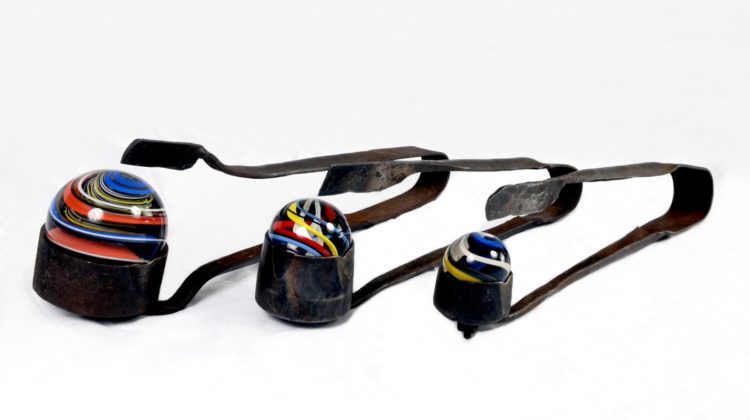
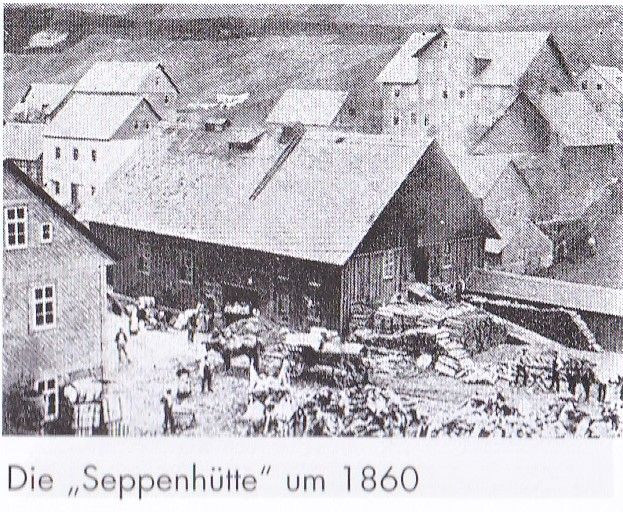
Used with permission of Dr.-Ing. Gerhard Greiner-Bär.
Sapere aude
In the Beginning…
B. Alan Basinet[1] made a significant contribution to our understanding of the setting, history, and beginnings of the Lauscha, Germany glassworks[2] . And we all recognize that Everrett Grist and Paul Baumann have become the sources to reference when identifying and pricing antique glass marbles. We have touched on the Lauscha glassworks in our recent posts.
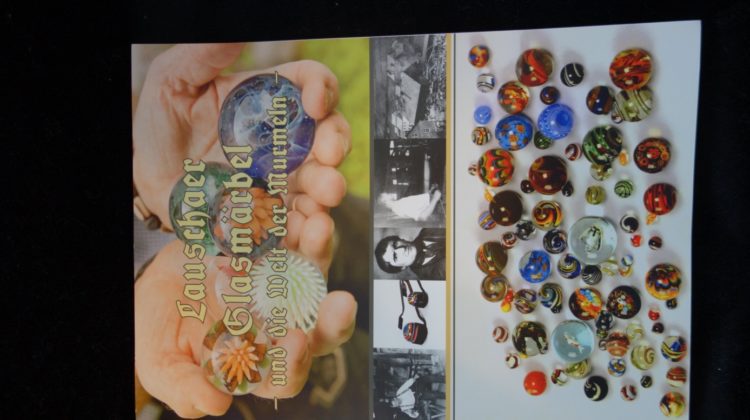
Antecedents as Precedents
Cover of book Lauschaer Glasmärbel —und der Welt der Murmeln— by Dr.-Ing. Gerhard Greiner-Bär. Used with permission.
In both of those posts we examine the Lauscha glassworks and recognize the contributions of Dr.-Ing. Gerhard Greiner-Bär in his 2019 book Lauschaer Glasmärbel —und der Welt der Murmeln and his recent Glow article about the development, history and production of Lauscha Christmas ornaments. We certainly do not intend to go back over plowed ground in this post.
However, we believe that antecedents sometimes serve as precedents and in the case of the development of modern glass marbles, Lauschau was certainly both antecedent and precedent to the work of J.H. Leighton’s 1890s “solid glass spheres.”[3] And Leighton opened the door to the ultimate development of production-run glass marbles by the millions.
One Cup of Sand, a Dash of Lime, and Don’t Forget the Flux!
In Chapter 1 Where Do Marbles Come From and Why? in our book The Secret Life of Marbles Their History and Mystery we tell about marbles from pre-Dynastic Egypt through their German development and into modern times. We spent a good deal of time studying Roman glass, and communicating with specialists who had years of experience in the field.
But we did not spend time in the book exploring one single critical element of the glass story. We did not attempt to trace the history and geographical distribution of Roman glass recipes into Europe. And all glass must have a recipe. “Wait,” you say, “I know most of the mid-20th century glass houses which ran marbles did not use recipe glass to run marbles!” Right. Cairo comes to mind. But the glass cullet which the glass houses used did require a recipe to produce.
How Glass Recipes May Have Gotten Their Start
Want to hear an interesting story about how glass recipes may have gotten their start? “According to the ancient Roman historian Pliny (23-79 A.D.), Phoenician merchants moored on the river Belus discovered glass accidentally in Syria around 5,000 BC. Pliny describes how by leaving cooking pots on blocks of nitrate near their fire, the merchants discovered glass as the blocks melted and mixed with the sand of the beach to form a non-transparent liquid.
However the first glass objects, mainly beads, date back to around 3,500 BC in Mesopotamia. The raw materials used for making glass were also used to make glazes on pots and vases. Phoenician merchants and sailors later spread the glass making techniques throughout the Mediterranean.” [4]
Nice story. We just wish it was true. We do know from experience in the Middle East that sand alone when heated only by a campfire can critically burn campers’ feet well after the fire is out. Pliny’s story is important because it illustrates the critical ingredients needed to make glass.
“Ancient” Rome is really a meaningless phrase. Pliny the Elder lived and wrote in Imperial Rome (the Roman Empire) which extended from 31 BC to 476 AD. The Roman Empire extended into Thuringia, Germany, home of Lauscha.
Not Your Mamma’s German Chocolate Cake
Pliny’s story (which would date to about 5,000 BC) contains all the elements of glass; soda, lime, and silica. Quartz sand (Silica) is mixed with soda. “To make the silica melt at a lower temperature, the Romans used soda (sodium carbonate). The source of soda during this period was natron, a type of salt found in dry lake beds.
Natron was imported from Egypt from a place called today Wadi El Natrun or “natron valley” in Arabic. Glassmakers would also use a stabiliser such as lime or magnesia. Lime was the primary stabiliser and it was naturally present in beach sand. They would also use colorants if they wanted the glass to have a specific color.” [5]
Question: would a German chocolate cake made with exactly the same ingredients in Morretes, Brazil, taste the same as it would if baked in Brazil, Indiana?
Another question: does the sand in the Steinfeld region of Germany contain the exact amount of quartz as the beach sand from the Mediterranean? Roman sodium carbonate was sourced from Egypt: where did German natron come from? Did they use plant ash as a flux instead? Would a Roman glass recipe, followed exactly, even produce glass in Lauscha? If not, how could the locals decide how to switch, swap, and augment the basic ingredients?
Basinet tells us that glass making in Lauscha dates to around the 1300s AD and that “secular residents” got their glass recipes from the Church. After all, it was Church members who could read Latin and that is the language that the recipes were written in. The 1300s would be during the Holy Roman Empire (738 – 1806). Charles IV was both German and a Holy Roman Emperor, and he promoted learning and literature in the mid 1300s.
For the Love of Place
A key idea in cultural geography is that there is a distinct bond between people and where they live. Think about it: people in large cities simply do not see the world in the same way as people on a tropical island or as people who live in the Schwarzwald or Black Forest of Germany. We have visited the Black Forest and other places as diverse as Batu Ferringhi, Malaysia, and Platis Gialos, Mykonos. We can say with certainty and from experience that where you are has a direct and real effect on who you are.
Lauscha is a town in the district of Sonneberg, in Thuringia, Germany. This modern State is home to the dense and rugged Thuringian Forest which played a key role in the development of glass in the region. The gorgeous uplands of the Forest have been called the green heart of Germany and they yielded plentiful timber to fuel the development of the glass works. We know that sand is also available. In fact, all of the natural ingredients are there to make glass.
Arminius, The Roman Legions[6], & Roman Trade
During the Roman Empire (31 BC to 476 AD) “Roman traders ranged widely throughout free Germany, stimulating the appetite of the natives for Roman export goods.” These goods included glass. “As the German market for Roman goods expanded, it promoted the development of small-scale manufacturing and processing in the frontier districts.
Glassware was also an important Roman export.
Several examples of first-century glassware have been discovered in Germany. Although some is clearly of Italian manufacture, the bulk was produced in the Rhineland. The frontier manufacturers attempted to appeal to German customers, who began making horn-shaped glass drinking vessels for the German market, and the product proved so popular that these models were soon employed throughout the empire.”
So, yes, Rome did influence the development of the glass industry in Germany. But it was hundreds of years earlier than the 1300s and it was not a passive exchange. It happened in a place and at a time where and when people were receptive to new things and ideas and capable of using their natural place to develop their own unique products. And these included, of course, the development of German glass.
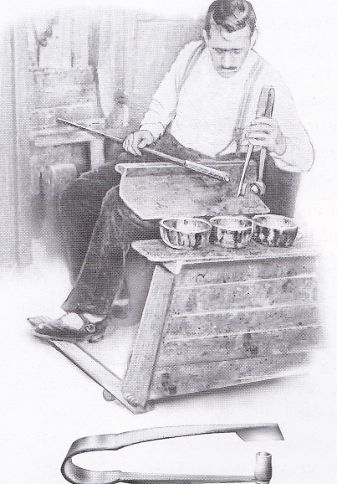
Used with permission.
Dr.-Ing. Gerhard Greiner-Bär speaks to this idea of place, history, and local creativity and innovation in Lauschaer Glasmärbel . In 3. „Die Erfindung der Glasmärbel“ (page 10) he writes: “The invention of the glass marble, as well as the subsequent development and production of the Firm of Elias Griener Vetter’s Sohn, like other epochal developments, testifies to the proverbial inventive spirit of the Lauscha glassmakers.“ (Translated from German.)
Last Dance in Lauscha
At the outset of this post we promised not to plow the same field so we defer now to Basinet, Baumann, Grist, and so many others who have traced the development of glass marbles in Germany.
For a long time we have read in reference books and online that Lauscha is recognized as the birthplace of not only modern glass marbles, but glass eyes as well! We know that human glass eyes (some are even a bit bloodshot) have historically been made there.
Robert Block in Marbles Identification and Price Guide, (5th Ed. page 15) notes that the „legendäre Märbelschere“, shown in the next pholtograph and which Gerhard Greiner-Bär explores in detail starting in Section 3 „Die Erfundung der Glasmarbel“ (page 10) were first used to produce „glass spheres for doll’s eyes.“ We know that there was a tremendous demand for toy and doll eyes in Lauscha village around the mid 1800s. You can still buy both antique and modern Lauscha glass eyes online. Just google it!
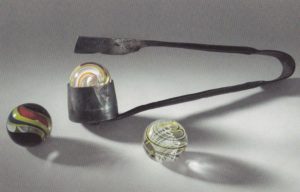
Used with permission.
What’s the Difference in Glass eyes and Modern Glass Marbles?
If you study some of the early glass eyes made in Lauscha you will quickly realize that there is little structural difference in the eyes and modern glass marbles. Gerhard Greiner-Bär told us something in an email while we researched this post which we had never heard before. He wrote: “…attempts to produce [glass] marbles were made in the local glassworks, which was built in 1594.
The inventor of the glass marble and the marble scissors Johann Christoph Simon Greiner, called “Vetterle”, was the half-brother of Elias Greiner-Vetter’s Sohn, and worked in the village glassworks as an animal eye maker. Elias Greiner Vetter’s Sohn and his son Septimius had shares in the village glassworks, so that the experiments could be carried out.” Elias’ and Septimius’ photographs are in Lauschaer Glasmärbel page 10). We translated from the German so we take responsibility for any mistakes.
In fact, taxidermy eyes were once made of glass
We have managed to collect one of these intended, we think, for a mountain goat! So both decorative eyes for toys and dolls and prosthetic eyes were produced to meet a growing domestic and worldwide demand in mid-18th century Lauscha. And that explains why the Märbelschere were not “one size fits all.“ We really prefer the smaller German handmade marbles.
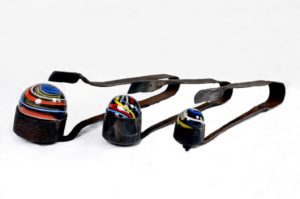
Used with permission.
The märbelschere were invented about 1846-1848. And Gerhard Greiner-Bär tells us that Seppenhütte, which is shown in 1860 in the first photograph in this post, the glassworks of Elias Greiner-Vetters Sohn, started production in 1853. There were several important glassworks in Lauscha besides Seppenhütte. These include: Schlotfegerhütte, Kühnertshütte, and Eugenshütte.
Now, look at your Alley, Cairo, Peltier, Alox, Akro, and Christensen marbles in a whole new light! Each shares a long Roman-German linage. We can only wish that the German precedent of invention, creativity, hard work, and innovation were still alive and still at work in the glass marble industry in the United States today!
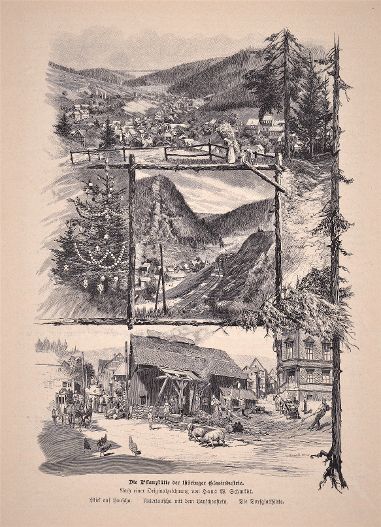
Id omnes gentes!
Notes on Modern Glass Marbles
[1] Basinet, B. Alan. A History of Glassmaking in Lauscha, Germany and Vicinity. The Museum of American Glass in West Virginia. http://www.magwv.com/magmarble/elias_greiner_vetters_shon.html 4/12/2022
[2] We translate Glashütte as glassworks. If you have any doubts about a glass hut check the photograph at the top of this post of the Seppenhütte by Elias Greiner Vetter’s son (1820 – 1979) which was taken in 1860.
[3] You might want to look back at Leighton’s 1891 U.S. Patent at https://patents.google.com/patent/US462083A/en 4/17/2022
[4] “Ancient Roman glass before the current era” vita-romae.com © 2013-2022. @ https://www.vita-romae.com/ancient-roman-glass.html (4/22/2022). Pliny the Elder, The Natural History, 36.65. Story is also in by Patrick Degryse, ed. Glass Making in the Greco-Roman World Results of the ARCHGLASS Project Leuven University Press Published with support of © 2014 by Leuven University Press / Presses Universitaires de Louvain / Universitaire Pers Leuven. Minderbroedersstraat 4, B-3000 Leuven (Belgium). https://library.oapen.org 4/13/2022 gives more understanding about the origins of modern glass marbles.
More Notes on Modern Glass Marbles
[5] “Ancient Roman glass before the current era”. See also If you want more detail on Roman glass and its chemistry check Royal Society of Chemistry at Roman glass and its chemistry https://www.rsc.org/ (4/20/2022) and 4/20/2022 “Glass Recipes and History” at http://www.ilpi.com/glassblowing/oldrecipes.html ( 4/20/2022). Trust us; its complicated in understanding the origins of Modern Glass Marbles!
[6] We are not going to discuss the ambush at Kalkriese on the north German plain. In 9 AD three of Roman’s best Legions were ambushed here and annulated. “It was a defeat so catastrophic that it threatened the survival of Rome itself and halted the empire’s conquest of Germany. “ Germany, while militarized afterwards, was left free. You may want to check Bordewich, Fergus M. “The Ambush That Changed History.” Smithsonian Magazine, Septgember 2006. Online at: https://www.smithsonianmag.com/history/the-ambush-that-changed-history-72636736/ 4/26/2022
[7] Nelson, Julie, and Steven K. Drummond. Roman Imperial Frontier in the West. Abingdon, Oxfordshire, UK: Routledge, 2015, pages 120-121. Check online at: https://books.google.com/books 4/25/2022
Read More About Marbles
Outstanding. I learned a lot.
Dr. Gerhard Greiner-Bar
Lauscha, GermanyThank you very much. It’s always interesting and refreshing to read your stories. Keep up the good work!

